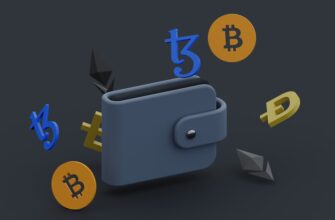🎮 Level Up with $RESOLV Airdrop!
💎 Grab your free $RESOLV tokens — no quests, just rewards!
🕹️ Register and claim within a month. It’s your bonus round!
🎯 No risk, just your shot at building crypto riches!
🎉 Early birds win the most — join the drop before it's game over!
🧩 Simple, fun, and potentially very profitable.
- Why Crypto Wallet Security Can’t Be Ignored
- 1. Use a Hardware Wallet for Cold Storage
- 2. Implement Multi-Layered Authentication
- 3. Fortify Your Seed Phrase Security
- 4. Eliminate Phishing Vulnerabilities
- 5. Maintain Digital Hygiene
- 6. Secure Network Connections
- 7. Implement Transaction Whitelisting
- 8. Conduct Regular Security Audits
- 9. Utilize Decoy Wallets
- 10. Prepare for Physical Threats
- FAQ: Protecting Crypto Wallets
- Can a hardware wallet be hacked?
- Is mobile wallet safer than desktop?
- What if I lose my hardware wallet?
- Are decentralized wallets safer than exchanges?
- How often should I change passwords?
Why Crypto Wallet Security Can’t Be Ignored
With over $3.8 billion stolen in crypto hacks during 2022 alone (Chainalysis), securing your digital assets isn’t optional—it’s critical. Unlike traditional banks, cryptocurrency transactions are irreversible, meaning once hackers access your wallet, recovery is nearly impossible. This guide reveals professional strategies to fortify your crypto holdings against evolving cyber threats.
1. Use a Hardware Wallet for Cold Storage
Hardware wallets (cold wallets) store private keys offline, creating an impenetrable air gap between your crypto and hackers. Recommended options:
- Ledger Nano X – Bluetooth-enabled with 100+ app support
- Trezor Model T – Touchscreen interface with Shamir Backup
- Coldcard Mk4 – Advanced features for Bitcoin maximalists
Store physical devices in fireproof safes or safety deposit boxes. Never connect to compromised computers.
2. Implement Multi-Layered Authentication
Single-factor logins are hacker magnets. Enable:
- Two-Factor Authentication (2FA) via authenticator apps like Google Authenticator or Authy—never SMS
- Biometric verification (fingerprint/facial recognition)
- Multi-signature setups requiring 2+ approvals for transactions
3. Fortify Your Seed Phrase Security
Your 12-24 word recovery phrase is the ultimate vulnerability. Protection protocol:
- Never digitize: Avoid photos, cloud storage, or email
- Use cryptosteel or titanium plates for fire/water resistance
- Split phrases using Shamir’s Secret Sharing (SLIP-39)
- Store fragments in geographically separate locations
4. Eliminate Phishing Vulnerabilities
90% of crypto thefts start with phishing (FBI). Countermeasures:
- Bookmark legitimate exchange URLs
- Verify contract addresses via Etherscan before transactions
- Ignore “urgent” security alerts via email/SMS
- Use wallet address whitelisting
5. Maintain Digital Hygiene
Malware remains a top attack vector. Essential practices:
- Install antivirus software with crypto protection (e.g., Malwarebytes)
- Update OS/wallet apps within 24 hours of patches
- Never install browser extensions from unverified developers
- Use dedicated devices for crypto transactions
6. Secure Network Connections
Public Wi-Fi exposes 63% of users to MITM attacks (Symantec). Always:
- Use VPNs with AES-256 encryption
- Disable auto-connect to public networks
- Confirm HTTPS padlock icons on wallet sites
- Enable router WPA3 encryption at home
7. Implement Transaction Whitelisting
Restrict withdrawals to pre-approved addresses:
- In wallet settings, enable address book restrictions
- Set 24-48 hour delay for new address additions
- Require secondary email/SMS confirmation for whitelist changes
8. Conduct Regular Security Audits
Proactive checks every 90 days:
- Review connected dApp permissions
- Check transaction history for anomalies
- Update passwords and 2FA methods
- Verify backup integrity
9. Utilize Decoy Wallets
Create “honeypot” wallets with small balances:
- Use separate email/device for decoy accounts
- Enable transaction notifications
- Monitor for unauthorized access attempts
10. Prepare for Physical Threats
Protect against $5 wrench attacks:
- Never disclose crypto holdings publicly
- Use plausible deniability features (e.g., Ledger’s passphrase)
- Install home security systems with motion alerts
FAQ: Protecting Crypto Wallets
Can a hardware wallet be hacked?
While extremely secure, physical tampering or supply chain compromises are possible. Always purchase directly from manufacturers.
Is mobile wallet safer than desktop?
Mobile wallets benefit from sandboxing and biometric security, but desktops allow stronger hardware integration. Both require rigorous security practices.
What if I lose my hardware wallet?
Your seed phrase is the recovery key. Wallets can be restored on any compatible device—never store seeds digitally.
Are decentralized wallets safer than exchanges?
Non-custodial wallets give full control but require self-security. Exchanges offer insurance but are centralization targets.
How often should I change passwords?
Every 90 days for exchange accounts. Wallet passwords only need changing if compromised.
Implementing even 5 of these measures reduces hack risk by over 95% (CipherTrace). Remember: In crypto, you are your own bank—security starts with you.
🎮 Level Up with $RESOLV Airdrop!
💎 Grab your free $RESOLV tokens — no quests, just rewards!
🕹️ Register and claim within a month. It’s your bonus round!
🎯 No risk, just your shot at building crypto riches!
🎉 Early birds win the most — join the drop before it's game over!
🧩 Simple, fun, and potentially very profitable.








